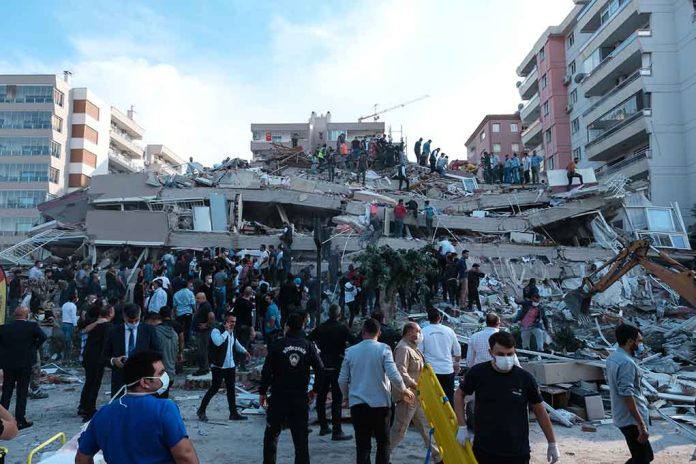
Russia steps in as nuclear-armed India and Pakistan inch closer to military confrontation following a deadly attack that killed 26 civilians in Kashmir.
Key Takeaways
- A militant attack in Pahalgam, Indian-administered Kashmir, resulted in 26 civilian deaths, drawing parallels to the 2008 Mumbai attacks
- India has accused Pakistan-based militant groups of orchestrating the attack, while Pakistan denies any involvement
- Russia has officially called for de-escalation between the nuclear neighbors, with Foreign Minister Sergei Lavrov communicating with both countries
- Pakistan has conducted a second missile test since tensions began, while India has responded with diplomatic and economic measures, including border closures and expelling diplomats
- The threshold for military escalation between India and Pakistan has increased since 2016, with cross-border and aerial strikes becoming more normalized
Kremlin Urges Restraint as Nuclear Powers Face Off
The Kremlin has officially called for de-escalation between India and Pakistan as tensions reach dangerous levels following a devastating terrorist attack in Indian-administered Kashmir. Russia’s intervention comes at a critical moment when both nuclear-armed nations appear to be inching toward military confrontation. The attack in Pahalgam, which claimed 26 civilian lives, has been compared to previous incidents that triggered military responses from India, raising global concerns about potential escalation in one of the world’s most volatile regions.
Kremlin spokesman Dmitry Peskov expressed serious concern over the rapidly deteriorating situation, emphasizing Russia’s position that both countries must take immediate steps to reduce tensions. Moscow has positioned itself as a potential mediator, leveraging its strong relationships with both nations. Russia maintains especially close ties with India as its largest weapons supplier, while also valuing its strategic relationship with Pakistan in a region where America’s influence has been steadily declining.
BREAKING – Russia calls for de-escalation in India-Pakistan tensionshttps://t.co/AxlnVwnksk
— Insider Paper (@TheInsiderPaper) May 5, 2025
Deadly Attack Triggers Crisis
The current crisis was sparked by a militant attack in Pahalgam that has drawn immediate comparisons to both the 2008 Mumbai attacks and the 2019 Pulwama bombing, which led to Indian airstrikes on Pakistani territory. India has directly accused Pakistan-based militant groups of orchestrating the attack, an allegation that Pakistan vehemently denies. The incident has reopened deep wounds between the neighboring countries that have fought multiple wars since their independence from British rule in 1947.
“There are striking parallels between the aftermath of the Pulwama bombing and the killings in Pahalgam,” said Ajay Bisaria. This attack carries elements of Pulwama, but much more of Mumbai. We’re once again in a conflict situation, and the story is unfolding in much the same way.
India has responded to the attack with a series of diplomatic and economic measures, including closing borders, suspending treaties, and expelling Pakistani diplomats. Pakistan has retaliated with visa suspensions and airspace restrictions. Most concerning to international observers is Pakistan’s decision to conduct a second missile test since the tensions began, a move viewed by many as a provocative display of military readiness.
Russia’s Strategic Intervention
Russian President Vladimir Putin has personally assured Indian Prime Minister Narendra Modi of the strong partnership between Russia and India, while simultaneously working through diplomatic channels to prevent military confrontation. Foreign Minister Sergei Lavrov has been in direct communication with officials from both countries, offering Russia’s services as a mediator in the crisis. This intervention demonstrates Russia’s growing influence in South Asia at a time when Western powers remain distracted by conflicts in Ukraine and the Middle East.
The stakes couldn’t be higher as both India and Pakistan possess nuclear weapons. Military analysts note that the threshold for military escalation between the two countries has increased since 2016, with cross-border operations and aerial strikes becoming more normalized. The Indus Waters Treaty, which has survived previous conflicts and ensures Pakistan’s access to crucial water resources, is now potentially at risk as India considers all options in response to the attack.
Regional Stability Hangs in Balance
As diplomatic efforts continue, India is pushing for international recognition of Jaish-e-Mohammad as a terrorist organization, a move that would further isolate Pakistan on the global stage. While military action has not yet been taken by India, the situation remains highly volatile. The international community watches anxiously as Russia attempts to keep both nations at the dialogue table, preventing a catastrophic escalation that could destabilize the entire region and potentially draw in other global powers.
President Trump’s administration is monitoring the situation closely, as any major conflict between these nuclear powers would have significant implications for U.S. interests in the region. For now, Russia’s intervention represents the most active diplomatic effort to defuse the crisis and prevent what could become one of the most dangerous military confrontations in recent history.









